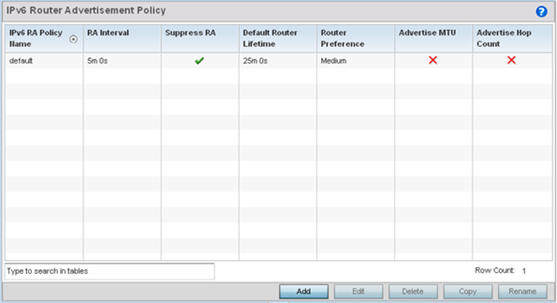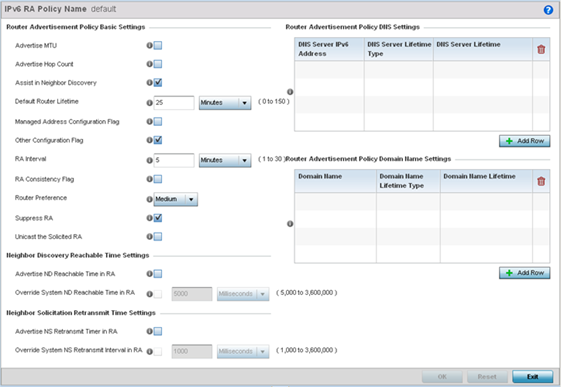IPv6 Router Advertisment Policy
About this task
An IPv6 router policy allows routers to advertise their presence in response to solicitation messages. After receiving a neighbor solicitation message, the destination node sends an advertisement message. which includes the link layer address of the source node. After receiving the advertisement, the destination device replies with a neighbor advertisement message on the local link. After the source receives the advertisement it can communicate with other devices.
Advertisement messages are also sent to indicate a change in link layer address for a node on the local link. With such a change, the multicast address becomes the destination address for advertisement messages.
To define a IPv6 router advertisement policy:
Procedure
-
Select ConfigurationNetworkIPv6 Router Advertisement Policy.


-
Select Add to create a new IPv6 router advertisement
policy, Edit to modify the attributes of a selected
policy or Delete to remove obsolete policies from the
list of those available. Existing policies can be copied or renamed as needed.
Provide a 32 character maximum name for the policy in the IPv6 RA
Policy Name field. Select OK to proceed.
The IPv6 RA Policy Name screen displays.


-
Set the following Router Advertisement Policy Basic
Settings:
Advertise MTU Select this option to include the Maximum Transmission Unit (MTU) in the router advertisements. The default setting is disabled Advertise Hop Count Select this option to include the hop count in the header of outgoing IPv6 packets. The default setting is disabled. Assist in Neighbor Discovery Select this option to send the source link layer address in a router advertisement to assist in neighbor discovery. The default setting is enabled. Default Router Lifetime Set the default router lifetime availability for IPv6 router advertisements. A lifetime of 0 indicates that the router is not a default router. The router advertisement interval range is 0 - 9000 Seconds, 0 - 150 Minutes, or 0 - 2.5 Hours. The default is 30 Managed Address Configuration Flag Select this option to send the managed address configuration flag in router advertisements. When set, the flag indicates that the addresses are available via DHCP v6. The default setting is disabled Other Configuration Flag Select this option to send the other configuration flag in router advertisements. When set, the flag indicates other configuration information (DNS related information, information on other servers within the network) is available via DHCP v6. The default RA Interval Set the interval for unsolicited IPv6 router assignments. The router advertisement interval range is 3 - 1800 seconds or 0 - 150 minutes. The default is 5 minutes. RA Consistency Flag Select this option to check if parameters advertised by other routers on the local link are in conflict with those router advertisements by this controller, service platform or Access Point. This option is disabled. Router Preference Set a High, Medium or Low preference designation on this router versus other router resource that may be available to the controller, service platform or Access Point. The default setting is medium. Suppress RA Use this setting to enable or diable the transmission of a router advertisement within the IPv6 packet. This setting is enabled by default. Unicast the Solicited RA Select this option to enable the unicast (single destination) transmission of a router advertisement within the IPv6 packet. This setting is disabled by default. -
Set the following Neighbor Discovery Reachable Time
Settings:
Advertise ND Reachable Time in RA Select this option not specify the neighbor reachable time in the router advertisements. When unspecified, the neighbor reachable time configured for the system is advertised. The default setting is disabled. Override System ND Reachable Time in RA Set the period for sending neighbor reachable time in the router advertisements. When unspecified, the neighbor reachable time configured for the system is advertised. The interval range is from 5,000 - 3,600,000 milliseconds. The default is 5000 milliseconds. -
Set the following Neighbor Solicitation Retransmit Time
Settings:
Advertise NS Retransmit Timer in RA Select this option to not specify the neighbor solicitation retransmit timer value in router advertisements. The default setting is disabled. Override System NS Retransmit Interval in RA Set the period for sending the neighbor solicitation retransmit timer in router advertisements. When unspecified, the setting configured for the system is advertised. The interval range is from 1000 - 3,600,000 milliseconds. The default is 1000 milliseconds. -
Select + Add Row under the Router
Advertisement Policy DNS Settings table and set the
following:
DNS Server IPv6 Address Use a DNS server to resolve host names to IPv6 addresses. When an IPv6 host is configured with the address of a DNS server, the host sends DNS name queries to the server for resolution. This field is mandatory DNS Server Lifetime Type Set the lifetime afforded to the DNS server resource. Options include expired, External (fixed), and infinite. The default is External (fixed). DNS Server Lifetime Set the maximum time the DNS server is available for name resolution. The interval range is from 1000 - 3,600,000 milliseconds. The default is 10 minutes. -
Select + Add Row under the Router
Advertisement Policy Domain Name Settings table and define the
following settings:
Domain Name Enter a fully qualified domain name (FQDN) is an unambiguous domain name available a router advertisement resource. To distinguish an FQDN from a regular domain name, a trailing period is added. For example, somehost.example.com. This field is mandatory. Domain Name Lifetime Type Set the DNS Server Lifetime Type. Options include expired, External (fixed), and infinite. The default is External (fixed). Domain Name Lifetime Set the maximum time the DNS domain name is available as a name resolution resource. The default is 10 minutes. - Select OK to save the changes, Reset to revert to the last saved configuration or Exit to close the screen.


